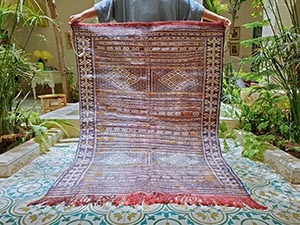Collecting vintage Southwest area rugs can be a fascinating hobby for those who appreciate the beauty and cultural significance of these unique textiles. However, it is important to know how to identify authentic pieces to avoid falling into the trap of purchasing counterfeit or mass-produced rugs.
One key aspect to consider when evaluating the authenticity of a vintage Southwest rug is its material. Genuine rugs from this region are typically hand-woven using natural fibers such as wool or cotton. Synthetic materials like polyester would be an unlikely choice for traditional weavers, so their presence may indicate a reproduction.
Another factor to take into account is the design and motifs found on the rug. Authentic Southwest area rugs often feature geometric patterns, inspired by Native American tribes' artistic heritage. These designs are usually symmetrical and meticulously crafted, reflecting the weaver's skill and attention to detail. Any asymmetry or lack of precision might suggest that the rug is not an original piece.
Additionally, examining the colors used in the rug can provide valuable clues about its authenticity. Traditional Southwest rugs tend to incorporate earthy tones like reds, browns, yellows, and blues derived from natural dyes obtained from plants or insects. Unusual or vibrant colors not commonly associated with this region could indicate a modern replica rather than an antique rug.
Furthermore, considering the age and condition of a vintage Southwest area rug is crucial in determining its authenticity. Genuine old rugs often display signs of wear that come with time and use. Vintage pieces may have slightly faded colors, worn fringes or edges, or even small repairs made by previous owners over generations. These imperfections lend character and history to the rug while replicas are more likely to appear pristine.
Lastly, seeking expert advice from reputable dealers or collectors specializing in authentic Southwestern textiles is highly recommended for beginners in this field. Their knowledge and experience can help distinguish genuine vintage rugs from fakes more accurately.
In conclusion, collecting vintage Southwest area rugs requires developing an eye for detail and familiarizing oneself with the characteristics of authentic pieces. By paying close attention to material, design, colors, age, and condition, enthusiasts can increase their chances of finding valuable and genuine rugs that truly reflect the rich cultural heritage of the Southwest region.
southwestern rugs wool
vintage handmade Southwestern rugs
